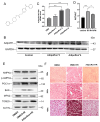AdipoRon Alleviates Liver Injury by Protecting Hepatocytes from Mitochondrial Damage Caused by Ionizing Radiation
- PMID: 39457060
- PMCID: PMC11508598
- DOI: 10.3390/ijms252011277
AdipoRon Alleviates Liver Injury by Protecting Hepatocytes from Mitochondrial Damage Caused by Ionizing Radiation
Abstract
Radiation liver injury is a common complication of hepatocellular carcinoma radiotherapy. It is mainly caused by irreversible damage to the DNA of hepatocellular cells directly by radiation, which seriously interferes with metabolism and causes cell death. AdipoRon can maintain lipid metabolism and stabilize blood sugar by activating adiponectin receptor 1 (AdipoR1). However, the role of AdipoRon/AdipoR1 in the regulation of ionizing radiation (IR)-induced mitochondrial damage remains unclear. In this study, we aimed to elucidate the roles of AdipoRon/AdipoR1 in IR-induced mitochondrial damage in normal hepatocyte cells. We found that AdipoRon treatment rescued IR-induced liver damage in mice and mitochondrial damage in normal hepatocytes in vivo and in vitro. AdipoR1 deficiency exacerbated IR-induced oxidative stress, mitochondrial dynamics, and biogenesis disorder. Mechanistically, the absence of AdipoR1 inhibits the activity of adenosine monophosphate-activated protein kinase α (AMPKα), subsequently leading to disrupted mitochondrial dynamics by decreasing mitofusin (MFN) and increasing dynamin-related protein 1 (DRP1) protein expression. It also controls mitochondrial biogenesis by suppressing the peroxisome proliferator-activated receptor-gamma coactivator-1 alpha (PGC1α) and transcription factor A (TFAM) signaling pathway, ultimately resulting in impaired mitochondrial function. To sum up, AdipoRon/AdipoR1 maintain mitochondrial function by regulating mitochondrial dynamics and biogenesis through the AdipoR1-AMPKα signaling pathway. This study reveals the significant role of AdipoR1 in regulating IR-induced mitochondrial damage in hepatocytes and offers a novel approach to protecting against damage caused by IR.
Keywords: AMPKα; AdipoR1; AdipoRon; ionizing radiation; liver injury; mitochondrial damage; radiation protection.
Conflict of interest statement
The authors declare no conflicts of interest.
Figures







Similar articles
-
AdipoRon Protects Against Secondary Brain Injury After Intracerebral Hemorrhage via Alleviating Mitochondrial Dysfunction: Possible Involvement of AdipoR1-AMPK-PGC1α Pathway.Neurochem Res. 2019 Jul;44(7):1678-1689. doi: 10.1007/s11064-019-02794-5. Epub 2019 Apr 13. Neurochem Res. 2019. PMID: 30982205
-
Novel Adiponectin Receptor Agonist Inhibits Cholangiocarcinoma via Adenosine Monophosphate-activated Protein Kinase.Curr Med Chem. 2024;31(28):4534-4548. doi: 10.2174/0109298673254969231122114107. Curr Med Chem. 2024. PMID: 38361349
-
AdipoRon improves cognitive dysfunction of Alzheimer's disease and rescues impaired neural stem cell proliferation through AdipoR1/AMPK pathway.Exp Neurol. 2020 May;327:113249. doi: 10.1016/j.expneurol.2020.113249. Epub 2020 Feb 15. Exp Neurol. 2020. PMID: 32070713
-
Exploring the Logic and Conducting a Comprehensive Evaluation of the Adiponectin Receptor Agonists AdipoRon and AdipoAI's Impacts on Bone Metabolism and Repair-A Systematic Review.Curr Med Chem. 2025;32(6):1168-1194. doi: 10.2174/0109298673308301240821052742. Curr Med Chem. 2025. PMID: 39206478
-
Current Insights into Molecular Mechanisms and Potential Biomarkers for Treating Radiation-Induced Liver Damage.Cells. 2024 Sep 16;13(18):1560. doi: 10.3390/cells13181560. Cells. 2024. PMID: 39329744 Free PMC article. Review.
Cited by
-
AdipoRon's Impact on Alzheimer's Disease-A Systematic Review and Meta-Analysis.Int J Mol Sci. 2025 Jan 8;26(2):484. doi: 10.3390/ijms26020484. Int J Mol Sci. 2025. PMID: 39859201 Free PMC article.
References
-
- Narayanan P.K., Goodwin E.H., Lehnert B.E. Alpha particles initiate biological production of superoxide anions and hydrogen peroxide in human cells. Cancer Res. 1997;57:3963–3971. - PubMed
MeSH terms
Substances
Grants and funding
LinkOut - more resources
Full Text Sources
Research Materials
Miscellaneous

